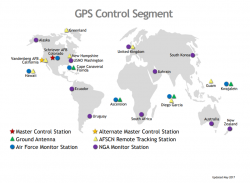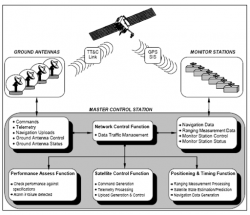If you wish to contribute or participate in the discussions about articles you are invited to contact the Editor
GPS Ground Segment
| GPS | |
|---|---|
| Title | GPS Ground Segment |
| Edited by | GMV |
| Level | Basic |
| Year of Publication | 2011 |
The GPS Ground Segment (also referred to as Control Segment or Operational Control System) is the responsible for the proper operation of the GPS system.
The GPS Control Segment consists of a global network of ground facilities that track the GPS satellites, monitor their transmissions, perform analysis, and send commands and data to the constellation[1].
Introduction

The Ground Segment, also referred to as Control Segment or Operational Control System, OCS, is the responsible for the proper operation of the GPS system. The main tasks performed by the CS are the following:
- Monitoring and control of satellite orbital parameters;
- Monitoring health and status of the satellite subsystems (solar arrays, battery power and the level of propellant used for maneuvers);
- Activation of spare satellites;
- Update of parameters in the navigation message (ephemeris, almanac and clock corrections);
- Resolving satellite anomalies;
- Controlling Selective Availability (SA) and Anti-Spoofing (A/S)
- Passive tracking of the satellites.
The Ground Segment is comprised of four major subsystems:[2]
- Master Control Station (MCS)
- Alternate Master Control Station
- Network of ground antennas (GAs),
- Network of globally-distributed monitor stations (MSs).
The current Operational Control Segment (OCS) includes a Master Control Station (MCS), an alternate Master Control Station, 11 command and control antennas (GA), and 16 monitoring sites (MS). The locations of these facilities are shown in the map below.[1]
The Master Control Station (MCS) processes the measurements received by the Monitor Stations (MS) to estimate satellite orbits (ephemerides) and clock errors, among other parameters, and to generate the navigation message. These corrections and the navigation message are uploaded to the satellites through the Ground Antennas, some of them co-located in four of the Monitor stations (Ascension Island, Cape Canaveral, Diego Garcia, and Kwajalein).
The Master Control Station
Located at Colorado Springs, the Master Control Station (MCS) is the central control node for the GPS satellite constellation. It is backed up by a fully operational alternate master control station. The MCS is responsible for all aspects of constellation command and control, including:[2]
- Provides command and control of the GPS constellation.
- Uses global monitor station data to compute the precise locations of the satellites.
- Generates navigation messages for upload to the satellites.
- Monitors satellite broadcast and system integrity to ensure constellation health and accuracy.
- Routine satellite bus and payload status monitoring.
- Performs satellite maintenance and anomaly resolution, including repositioning satellites to maintain optimal constellation.
- Currently uses separate systems (AEP and LADO) to control operational and non-operational satellites.
- Monitoring and management of GPS Signal-In-Space (SIS) performance to comply with all performance standards (SPS PS and PPS PS).
- Navigation message data upload operations as required to sustain performance in accordance with accuracy and integrity performance standards.
- Detecting and responding to GPS SIS failures.
The Monitor Stations
They are distributed around the world and equipped with atomic clocks standards and GPS receivers to continuously collect GPS data for all the satellites in view from their locations. The collected data is sent to the Master Control Station where it is processed to estimate satellite orbits (ephemerides) and clock errors, among other parameters, and to generate the Navigation Message. They also collect navigation signals, range/carrier measurements and atmospheric data.
Prior to the modernization program, the Monitor Stations network comprised five sites located in[3]:
- Hawaii,
- Colorado Springs (Colorado, US),
- Ascension Island (South Atlantic),
- Diego Garcia (Indian Ocean),
- Kwajalein (North Pacific).
In order to increase performance and accuracy, new stations were incorporated into the ground segment providing greater visibility of the constellation: Cape Canaveral (Florida, US) was incorporated in 2001 and six new stations in 2005:[4]
- Adelaide (Australia),
- Buenos Aires (Argentina),
- Hermitage (UK),
- Manama (Bahrain),
- Quito (Ecuador)
- Washington DC (USA).
Five more stations were added afterwards in 2006:
- Fairbanks (Alaska),
- Osan (South Korea),
- Papeete (Tahiti),
- Pretoria (South Africa)
- Wellington (New Zealand).
Currently the network is composed by 16 stations, 6 from the Air Force plus 10 from the NGA (National Geospatial-Intelligence Agency). With this configuration, each satellite is seen from at least three monitor stations,[3] which allows computing more precise orbits and ephemeris data, therefore improving system accuracy.
The Ground Antennas
The main functions of the Ground Antennas are:
- Send commands, navigation data uploads, and processor program loads to the satellites.
- Collect telemetry.
- Communicate via S-Band and perform S-Band ranging to provide anomaly resolution and early orbit support.
This information can be uploaded to each satellite three times per day, i.e., every 8 hours; nevertheless, it is usually updated just once a day.
The ground antennas are co-located in four of the Monitor stations:
- Ascension Island
- Cape Canaveral
- Diego Garcia
- Kwajalein
In addition, 7 Air Force Satellite Control Network (AFSCN) remote tracking stations are part of the Ground Antennas.
Control Segment Modernization
As part of the GPS modernization program, the Air Force has continuously upgraded the GPS control segment for many years. The ground upgrades are necessary to command and control the newer GPS satellites and to enhance cybersecurity. The Next Generation Operational Control System (OCX) is the future version of the GPS control segment. OCX will command all modernized (GPS III) and legacy GPS satellites, manage all civil and military navigation signals, and provide improved cybersecurity and resilience for the next generation of GPS operations. It will consist of[5]:
- A master control station and alternate master control station
- Dedicated monitor stations
- Ground antennas
- GPS system simulator and
- Standardized space trainer.
OCX development is following an incremental approach.[5]
- Block 0 is the Launch and Control System (LCS) intended to control Launch and Early Orbit (LEO) operations and the on-orbit checkout of all GPS III satellites. OCX Block 0 is a subset of OCX Block 1 providing the hardware, software, and cybersecurity base for Block 1.
- Block 1 fields the operational capability to control all legacy satellites and civil signals (L1 C/A), military signals (L1P(Y), L2P(Y)) as well as the GPS III satellites and the modernized civil signal (L2C) and the aviation safety-of-flight signal (L5). In addition, Block 1 will field the basic operational capability to control the modernized military signals (L1M and L2M (M-Code)), and the globally compatible signal (L1C). It also fully meets information assurance/cyber defense requirements.
- Block 2 fields the advanced operational capability to control the advanced features of the modernized military signals (L1M and L2M (M-Code)). Block 2 will be delivered concurrently with Block 1.
Notes
This article contains some verbatim paragraphs taken from U.S. governmental web pages. Please see the References section.
References
- ^ a b c GPS Ground Segment information in GPS official website
- ^ a b GPS Standard Positioning Service (SPS) Performance Standard, 4th Edition, September 2008
- ^ a b J. Sanz Subirana, JM. Juan Zornoza and M. Hernández-Pajares, Global Navigation Satellite Systems: Volume I: Fundamentals and Algorithms
- ^ GPS Modernization Fact Sheet
- ^ a b Next Generation Operational Control System (OCX) in GPS official website


